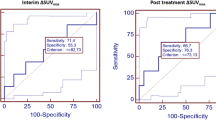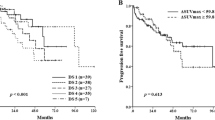Abstract
Currently, analysis of interim PET (iPET) according to the Deauville score (DS) is the most important predictive factor in Hodgkin lymphoma (HL); however, there is room for improvement in its prognostic power. This study aimed to evaluate the prognostic value of quantitative PET analysis (maximum standard uptake value [SUVmax], total metabolic tumor volume [TMTV] and total lesion glicolysis [TLG]) at baseline (PET0) and iPET in a retrospective cohort of newly diagnosed classical HL. For positive iPET (+ iPET), the reduction of quantitative parameters in relation to PET0 (ΔSUVmax, ΔTMTV and ΔTLG) was calculated. Between 2011 and 2017, 234 patients treated with ABVD were analyzed. Median age was 30 years-old, 59% had advanced stage disease, 57% a bulky mass and 25% a + iPET (DS 4–5). At baseline, high TLG was associated with an increased cumulative incidence of failure (CIF) (p = 0.032) while neither SUVmax, TMTV or TLG were associated with overall survival (OS) or progression-free survival (PFS). In multivariate analysis, only iPET was associated with CIF (p < 0.001). Among ΔSUVmax, ΔTMTV and ΔTLG, only a ΔSUVmax ≥ 68.8 was significant for PFS (HR: 0.31, CI95%: 0.11–0.86, p = 0.024). A subset of patients with improved PFS amongst + iPET was identified by the quantitative (ΔSUVmax ≥ 68.8%) analysis. In this real-world Brazilian cohort, with prevalent high-risk patients, quantitative analysis of PET0 did not demonstrate to be prognostic, while a dynamic approach incorporating the ΔSUVmax to + iPET succeeded in refining a subset with better prognosis. These findings warrant validation in larger series and indicate that not all patients with + iPET might need treatment intensification.


Similar content being viewed by others
Data availability
Data available on request from the corresponding author.
References
Klimm B, Goergen H, Fuchs M et al (2013) Impact of risk factors on outcomes in early-stage Hodgkin’s lymphoma: An analysis of international staging definitions. Ann Oncol 24:3070–3076. https://doi.org/10.1093/annonc/mdt413
Hasenclever D, Diehl V (1998) A prognostic score for advanced Hodgkin’s disease. N Engl J Med 339:1506–1514
Radford J, Illidge T, Counsell N et al (2015) Results of a trial of PET-directed therapy for early-stage Hodgkin’s lymphoma. N Engl J Med 372:1598–1607. https://doi.org/10.1056/NEJMoa1408648
André MPEE, Girinsky T, Federico M et al (2017) Early positron emission tomography response-adapted treatment in stage I and II hodgkin lymphoma: Final results of the randomized EORTC/LYSA/FIL H10 trial. J Clin Oncol 35:1786–1796. https://doi.org/10.1200/JCO.2016.68.6394
Trotman J, Fossa A, Federico M et al (2017) Response-adjusted therapy for advanced Hodgkin lymphoma (RATHL) trial: Longer follow up confirms efficacy of de-escalation after a negative interim PET scan (CRUK/07/033). Hematol Oncol 35:65–67. https://doi.org/10.1002/hon.2437
Johnson PW, Federico M, Fossa A et al (2015) Response-adapted therapy based on interim FDG-PET scans in advanced hodgkin lymphoma: First analysis of the safety of de-escalation and efficacy of escalation in the international rathl study (cruk/07/033). Hematol Oncol 33:102–103. https://doi.org/10.1002/hon.2227
Gallamini A, Rossi A, Patti K et al (2017) Early chemotherapy intensification with escalated BEACOPP in advanced-stage Hodgkin lymphoma with a positive interim PET-CT after 2 ABVD cycles: Long-term results of the GITIL/FIL HD 0607 trial. Haematologica 102:145–146
Gallamini A, Hutchings M, Rigacci L et al (2007) Early interim 2-[18F]fluoro-2-deoxy-D-glucose positron emission tomography is prognostically superior to international prognostic score in advanced-stage Hodgkin’s lymphoma: A report from a joint Italian-Danish study. J Clin Oncol 25:3746–3752. https://doi.org/10.1200/JCO.2007.11.6525
Zinzani PL, Broccoli A, Gioia DM et al (2016) Interim positron emission tomography response-adapted therapy in advanced-stage hodgkin lymphoma: Final results of the phase II part of the HD0801 study. J Clin Oncol 34:1376–1385. https://doi.org/10.1200/JCO.2015.63.0699
Johnson P, Federico M, Kirkwood A et al (2016) Adapted treatment guided by interim PET-CT scan in advanced Hodgkin’s lymphoma. N Engl J Med 374:2419–2429. https://doi.org/10.1056/NEJMoa1510093
Stephens DM, Li H, Schoder H et al (2019) Five-year follow-up of SWOG S0816: Limitations and values of a PET-adapted approach with stage III/IV Hodgkin lymphoma. Blood 134:1238–1246. https://doi.org/10.1182/blood.2019000719
Cerci JJ, Pracchia LF, Linardi CCG et al (2010) 18F-FDG PET after 2 cycles of ABVD predicts event-free survival in early and advanced Hodgkin lymphoma. J Nucl Med 51:1337–1343. https://doi.org/10.2967/jnumed.109.073197
Straus DJ, Dlugosz-Danecka M, Alekseev S, et al (2019) Brentuximab vedotin with chemotherapy for stage 3/4 classical Hodgkin lymphoma: Three-year update of the ECHELON-1 study. J Clin Oncol 37:. https://doi.org/10.1200/JCO.2019.37.15_suppl.7532
Cottereau AS, Versari A, Loft A, Casasnovas O, Bellei M, Ricci R, Cottereau A, Versari A et al (2017) Prognostic value of baseline total metabolic tumor volume (TMTV) for patients with early stage Hodgkin lymphoma enrolled in the standard arm of the H10 (EORTC/LYSA/FIL) trial. Hematol Oncol 35:35–36. https://doi.org/10.1002/hon.2437
Mettler J, Müller H, Voltin CA et al (2019) Metabolic tumor volume for response prediction in advanced-stage Hodgkin lymphoma. J Nucl Med 60:207–211. https://doi.org/10.2967/jnumed.118.210047
Pinochet P, Texte E, Stamatoullas-Bastard A, et al (2021) Prognostic value of baseline metabolic tumour volume in advanced-stage Hodgkin’s lymphoma. Sci Rep 11:. https://doi.org/10.1038/s41598-021-02734-w
Albano D, Mazzoletti A, Spallino M et al (2020) Prognostic role of baseline 18F-FDG PET/CT metabolic parameters in elderly HL: a two-center experience in 123 patients. Ann Hematol 99:1321–1330. https://doi.org/10.1007/s00277-020-04039-w
Barrington SF, Meignan M (2019) Time to prepare for risk adaptation in lymphoma by standardizing measurement of metabolic tumor burden. J Nucl Med 60:1096–1102. https://doi.org/10.2967/jnumed.119.227249
Cottereau AS, Versari A, Loft A et al (2016) Prognostic Value of Baseline Quantitative PET Metrics for Patients with Unfavourable Early Stage Hodgkin Lymphoma Enrolled in the Standard Arm of the EORTC/Lysa/FIL H10 Trial. Blood 128:184–184. https://doi.org/10.1182/blood.v128.22.184.184
Rossi C, Kanoun S, Berriolo-Riedinger A et al (2014) Interim 18f-FDG PET Suvmax reduction is superior to visual analysis in predicting outcome early in Hodgkin lymphoma patients. J Nucl Med 55:569–573. https://doi.org/10.2967/jnumed.113.130609
Bonadonna G, Zucali R, Monfardini S et al (1975) Combination chemotherapy of Hodgkin’s disease with adriamycin, bleomycin, vinblastine, and imidazole carboxamide versus MOPP. Cancer 36:252–259. https://doi.org/10.1002/1097-0142(197507)36:1%3c252::AID-CNCR2820360128%3e3.0.CO;2-7
Cheson BD, Fisher RI, Barrington SF et al (2014) Recommendations for initial evaluation, staging, and response assessment of Hodgkin and non-Hodgkin lymphoma: The Lugano classification. J Clin Oncol 32:3059–3067. https://doi.org/10.1200/JCO.2013.54.8800
Engert A, Plütschow A, Eich HT et al (2010) Reduced treatment intensity in patients with early-stage Hodgkin’s lymphoma. N Engl J Med 363:640–652. https://doi.org/10.1056/NEJMoa1000067
Barrington SF, Mikhaeel NG, Kostakoglu L et al (2014) Role of imaging in the staging and response assessment of lymphoma: Consensus of the international conference on malignant lymphomas imaging working group. J Clin Oncol 32:3048–3058. https://doi.org/10.1200/JCO.2013.53.5229
Boellaard R, Delgado-Bolton R, Oyen WJG et al (2014) FDG PET/CT: EANM procedure guidelines for tumour imaging: version 2.0. Eur J Nucl Med Mol Imaging 42:328–354. https://doi.org/10.1007/s00259-014-2961-x
Contal C, O’Quigley J (1999) An application of changepoint methods in studying the effect of age on survival in breast cancer. Comput Stat Data Anal 30:253–270. https://doi.org/10.1016/S0167-9473(98)00096-6
Lin LH, Hedayat A, Wu W (2012) Statistical tools for measuring agreement. Springer
Biasoli I, Castro N, Delamain M et al (2018) Treatment outcomes for Hodgkin lymphoma: First report from the Brazilian Prospective Registry. Hematol Oncol 36:189–195. https://doi.org/10.1002/hon.2450
Mahuad C, Victoria O, Laura K, Enriqueta M, Fernando W, Hernán GR et al (2022) Retrospective multicenter real-life study on the first-line treatment of classical Hodgkin lymphoma in Argentina. Clin Hematol Int 4:44–51. https://doi.org/10.1007/s44228-022-00008-4
Rukavitsyn AA, Kurbanov SI, Rukavitsyn OA (2017) Prognostic and Differential Diagnostic Value of Standardized Uptake Volume (SUV) of Fluorodeoxyglucose in Patients with Hodgkin’s Lymphoma. Clin Oncohematol 10:182–186. https://doi.org/10.21320/2500-2139-2017-10-2-182-186
Angelopoulou MK, Mosa E, Pangalis GA et al (2017) The significance of PET/CT in the initial staging of hodgkin lymphoma: Experience outside clinical trials. Anticancer Res 37:5727–5736. https://doi.org/10.21873/anticanres.12011
Akhtari M, Milgrom SA, Pinnix CC et al (2018) Reclassifying patients with early-stage Hodgkin lymphoma based on functional radiographic markers at presentation. Blood 131:84–94. https://doi.org/10.1182/blood-2017-04-773838
Tseng D, Rachakonda L, Su Z, Advani R, Horning SHR et al (2012) Interim-treatment quantitative PET parameters predict progression and death among patients with hodgkin’s disease Tseng D. Radiat Oncol 7:1–7
Kanoun S, Rossi C, Berriolo-Riedinger A et al (2014) Baseline metabolic tumour volume is an independent prognostic factor in Hodgkin lymphoma. Eur J Nucl Med Mol Imaging 41:1735–1743. https://doi.org/10.1007/s00259-014-2783-x
Casasnovas RO, Kanoun S, Tal I, Cottereau AS, Edeline V, Brice P et al (2016) Baseline total metabolic volume (TMTV) to predict the outcome of patients with advanced Hodgkin lymphoma (HL) enrolled in the AHL2011 LYSA trial. J Clin Oncol 34:7509. https://doi.org/10.1200/JCO.2016.34.15_suppl.7509
Song MK, Chung JS, Lee JJ et al (2013) Metabolic tumor volume by positron emission tomography/computed tomography as a clinical parameter to determine therapeutic modality for early stage Hodgkin’s lymphoma. Cancer Sci 104:1656–1661. https://doi.org/10.1111/cas.12282
Rigacci L, Puccini B, Zinzani PL et al (2015) The prognostic value of positron emission tomography performed after two courses (INTERIM-PET) of standard therapy on treatment outcome in early stage Hodgkin lymphoma: A multicentric study by the fondazione italiana linfomi (FIL). Am J Hematol 90:499–503. https://doi.org/10.1002/ajh.23994
Straus DJ, Dlugosz-Danecka M, Connors JM et al (2020) Brentuximab Vedotin with Chemotherapy for Patients with Previously Untreated, Stage III/IV Classical Hodgkin Lymphoma: 5-Year Update of the ECHELON-1 Study. Blood 136:26–28. https://doi.org/10.1182/blood-2020-137089
Herrera AF, LeBlanc ML, Castellino SM et al (2023) SWOG S1826, a randomized study of nivolumab(N)-AVD versus brentuximab vedotin(BV)-AVD in advanced stage (AS) classic Hodgkin lymphoma (HL). J Clin Oncol 41:LBA4–LBA4. https://doi.org/10.1200/JCO.2023.41.17\_suppl.LBA4
Hutchings M, Mikhaeel NG, Fields PA et al (2005) Prognostic value of interim FDG-PET after two or three cycles of chemotherapy in Hodgkin lymphoma. Ann Oncol 16:1160–1168. https://doi.org/10.1093/annonc/mdi200
Zinzani PL, Rigacci L, Stefoni V et al (2012) Early interim 18F-FDG PET in Hodgkin’s lymphoma: evaluation on 304 patients. Eur J Nucl Med Mol Imaging 39:4–12. https://doi.org/10.1007/s00259-011-1916-8
Gallamini AA, Barrington SF, Biggi A et al (2014) The predictive role of interim positron emission tomography for Hodgkin lymphoma treatment outcome is confirmed using the interpretation criteria of the Deauville five-point scale. Haematologica 99:1107–1113. https://doi.org/10.3324/haematol.2013.103218
Zheng S, Gupta K, Goyal P et al (2023) Outcomes of patients with positive pnterim Positron Emission Tomography (PET) continuing ABVD in the clinical setting. Cancers (Basel) 15:1760. https://doi.org/10.3390/cancers15061760
Yang S, Qiu L, Huang X et al (2020) The prognostic significance of ΔSUVmax assessed by PET/CT scan after 2 cycles of chemotherapy in patients with classic Hodgkin’s lymphoma. Ann Hematol 99:293–299. https://doi.org/10.1007/s00277-019-03892-8
Author information
Authors and Affiliations
Contributions
FMS, VB, CAB, VR designed the research study; LBOS created the database, FMS collected the clinical data; JFGM, MSL performed the PET-CT analysis; FRM, LBOS, WSFJ contributed to statistical analysis; FMS, WSFJ, ACAM, MJA, RDV contributed to interpretation of the results; FMS drafted the manuscript; VB, CAB, VR provided critical review.
Corresponding author
Ethics declarations
Ethical appproval
The study was approved by the ethics committee of the Faculdade de Medicina of the Universidade de Sao Paulo in accordance with the ethical standards of the institutional and national research committee and with the 1964 Helsinki declaration and its later amendments or comparable ethical standards (number: 79442717.0.0000.0065—CAAE- Plataforma Brasil).
Competing interests
No authors have conflicts of interest or funding to disclose.
Additional information
Publisher's Note
Springer Nature remains neutral with regard to jurisdictional claims in published maps and institutional affiliations.
Valeria Buccheri and Vanderson Rocha share the last position of authorship.
Supplementary Information
Below is the link to the electronic supplementary material.
Rights and permissions
Springer Nature or its licensor (e.g. a society or other partner) holds exclusive rights to this article under a publishing agreement with the author(s) or other rightsholder(s); author self-archiving of the accepted manuscript version of this article is solely governed by the terms of such publishing agreement and applicable law.
About this article
Cite this article
Santos, F.M., Marin, J.F.G., Lima, M.S. et al. Impact of baseline and interim quantitative PET parameters on outcomes of classical Hodgkin Lymphoma. Ann Hematol 103, 175–183 (2024). https://doi.org/10.1007/s00277-023-05461-6
Received:
Accepted:
Published:
Issue Date:
DOI: https://doi.org/10.1007/s00277-023-05461-6




